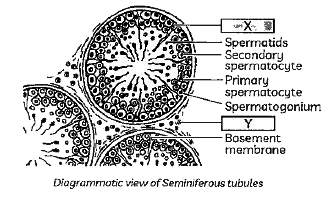Identify the cells that provide nutrition to the germ cells.
Sertoli cells
Leydig cells
Serniniferous
Septa
The correct Answer is:A
Step-by-Step Solution:
1. Understanding Germ Cells: Germ cells are the reproductive cells that develop into sperm in males. They require nutrition and support for their growth and development.
2. Identifying Relevant Cells: In the male reproductive system, there are specific cells that support the germ cells. The question asks for the cells that provide nutrition to these germ cells.
3. Recognizing Sertoli Cells: Sertoli cells are located within the seminiferous tubules of the testes. They play a crucial role in the nourishment and support of developing sperm cells (germ cells).
4. Function of Sertoli Cells: Sertoli cells provide essential nutrients and support to the germ cells. They help in the maturation of sperm by engulfing and providing the necessary substances for their growth.
5. Conclusion: The cells that provide nutrition to the germ cells are the Sertoli cells.
Final Answer: Sertoli cells.
---
Topper's Solved these Questions
- BOOK - PEARSON IIT JEE FOUNDATIONCHAPTER - REPRODUCTION IN HUMAN BEINGSEXERCISE - MASTERING THE CONCEPTS (Assertions and Reasons )11videos
REPRODUCTION IN HUMAN BEINGS
- BOOK - PEARSON IIT JEE FOUNDATIONCHAPTER - LIFE PROCESSES IN PLANTSEXERCISE - ASSESSMENT TESTS (ANSWER THE FOLLOWING QUESTIONS)14videos
LIFE PROCESSES IN PLANTS
- BOOK - PEARSON IIT JEE FOUNDATIONCHAPTER - REPRODUCTION IN LOWER ORGANISMS AND PLANTSEXERCISE - ASSESSMENT TESTS (ANSWER THE FOLLOWING QUESTIONS)11videos
REPRODUCTION IN LOWER ORGANISMS AND PLANTS
Similar Questions
Sertoli cells are found in
(A) ovaries and secrete progesterone
(B) adrenal cortex and secrete adrenalin
(C) seminiferous tubules and provide nutrition to germ cells
(D) Uterine wall and help implantationView SolutionWhich one of the following statement is correct about sertoli cells also called as nurse cells?
(A) Found in adrenal cortex and secrete adrenaline
(B) Found in ovaries and secrete progesterone
(C) Found in pancreas and secrete cholecystokinin
(D) Found in Seminiferous tubules and provide nutrition of germ cellsView Solution
Knowledge Check
- Question 1 - Select One
Assertion: Interstitial cell is present in the region outside the seminiferous tubule called interstitial spaces.
Reason: Interstitial cells provide nutrition to the sertoli cells.AIf both assertion and reason are true and the reason is the correct explanation of the assertion.BIf both assertion and reason are true but reason is not the correct explanation of the assertion.CIf the assertion is true but reason is false.DIf both assertion and reason are false. - Question 2 - Select One
The mutation in germ cells
AAre more deleteriousBAre less deleteriousCCan be detected only in the next generationDCan be detected in the dame generation of an individual - Question 3 - Select One
Which provides nutrition to maturing sperms?
ALeydig cellsBScrotumCEpididymisDSertoli cells.
Which cells provide nutrition to the developing sperms in seminiferous tubules ?
View SolutionIdentify the longest cell.
View Solution_____ provides nutrition for the egg in the embryo sac.
View SolutionExtra structure that provides nutrition to embryo is
View SolutionObserve the given diagram and find out the correct statement:

(I) X are Sertoli cells
(II) Y are Leydig cells
(III) X provides nutrition to spermatocytes
(IV) Y provides nutrition to spermatocytesView Solution
